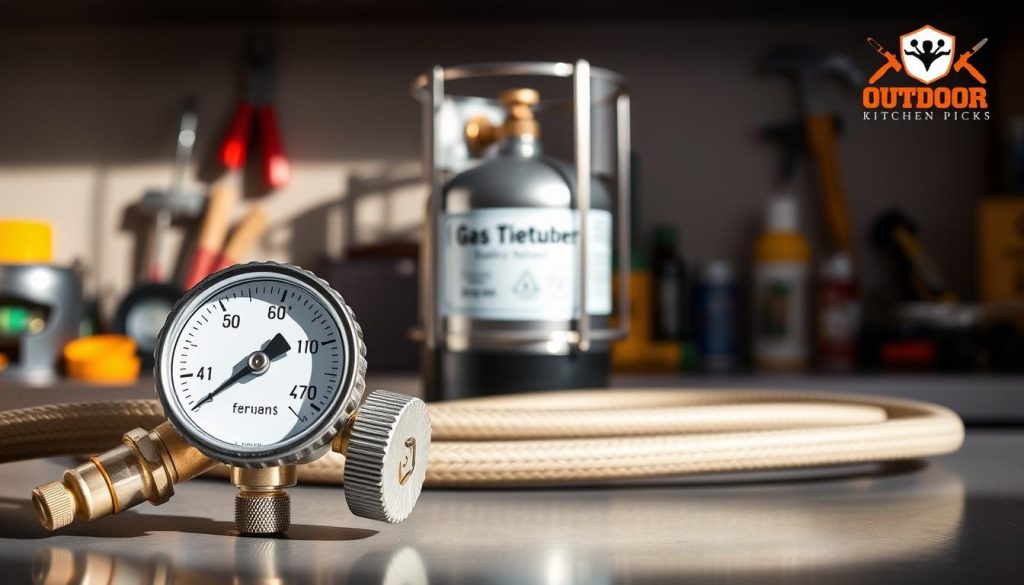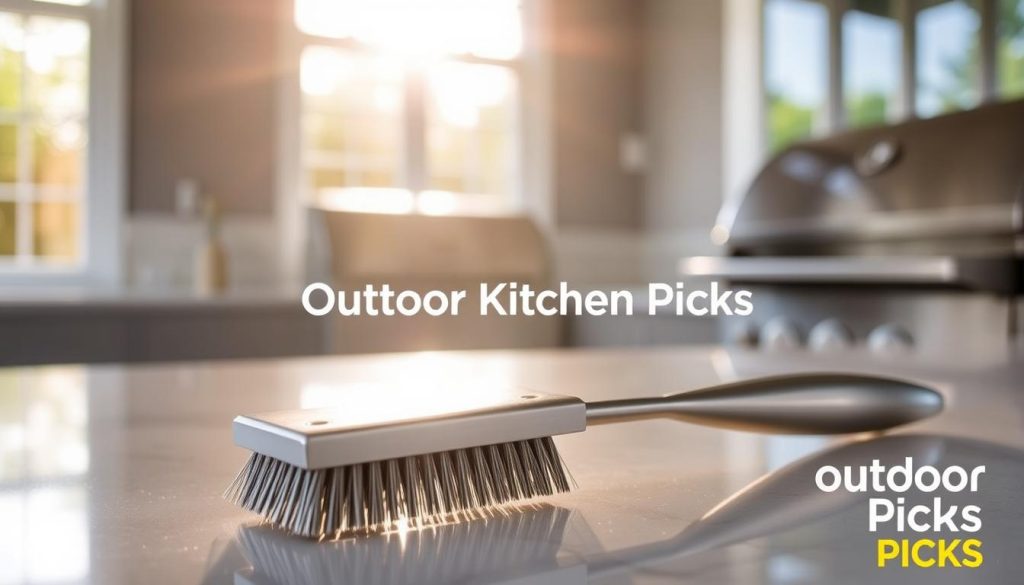Surprising fact: over 60% of backyard cooks notice tastier meals and fewer flare‑ups after regular maintenance.
We know a clean grill makes a real difference in flavor, performance, and the life of your gear. Before we touch anything, make sure the propane tank is off and disconnected, or close the natural gas shutoff between the unit and the line.
Lay down a tarp or paper to catch drips and snap photos as you remove parts so reassembly is simple. Deep-clean the interior monthly if you fire up the grill often, or quarterly if you use it less.
We’ll walk through a clear, step‑by‑step process that shows which parts to remove, what to keep dry inside the burner tubes, and how long each stage should take. Thorough drying prevents rust and saves you time later.
Key Takeaways
- Turn off and disconnect the fuel before starting any work.
- Protect your workspace with a tarp and photograph part placement for easy reassembly.
- Deep-clean frequency: monthly for heavy use, quarterly for light use.
- Keep burner interiors dry to prevent rust and keep flames steady.
- We’ll cover simple safety checks like even blue flames and air shutter tweaks.
Safety first: disconnect the gas supply and prepare your workspace
Before we touch a single part, safety must lead the way. The first priority is cutting the gas supply so there is no fuel flow while we work on the grill.

Shut off the tank or the supply line
For propane, close the LP tank valve and disconnect it. For natural setups, shut the valve at the grill’s line so the connection is dead.
Cool down, cover the area, and gather gear
Let residual heat drop before you touch grates or shields. Lay down paper or a tarp under the unit to catch soot and grease. This protects patio surfaces and speeds cleanup.
- Wear gloves and eye protection and keep a grill brush ready.
- Set aside small containers for screws, pins, and clips so every parts return correctly.
- Work on a flat, stable surface and double‑check for any lingering gas smell. If you detect it, ventilate and re‑inspect before moving on.
We plan with care. A few prep steps save time, protect equipment, and let us perform a thorough, clean gas maintenance session. Make sure you follow these checks before proceeding with deeper cleaning or repairs.
Essential tools and materials for a clean gas grill and burners
Before we lift a grate, let’s gather the right tools so the job goes smoothly. A compact kit keeps parts organized and prevents damage to metal surfaces.

- Sturdy grill brush and a small wire brush for ports.
- Mild dish soap for soapy water, plus plenty of water and paper or microfiber towels.
- Nitrile gloves, a plastic scraper or putty knife, and a small bin to hold parts.
We prefer a stainless steel cleaner for the lid and a gentle soap for painted or porcelain surfaces. Avoid harsh abrasives on stainless; scrub with the grain.
Extras that help: compressed air for clogged tubes, a straightened paper clip for tight ports, and an optional degreaser for baked‑on food. Rinse and dry grates fully before reassembly.
“A little prep and the right tools make maintenance faster and keep flavors clean.”
Step-by-step: how to clean gas grill burners safely
We’ll walk the removal and inspection steps so each burner performs like new.
Access and remove parts
Lift the grates and pull off heat tents or flame shields. Brush loose food and grease, then set each piece aside in order.
Detach the tubes
Pull locking pins and screws, then lift each burner off the orifice. Keep small hardware in a tray so reassembly is simple.
Exterior cleaning and port care
Wash the outside of the tube with soapy water and a wire brush. Never run water through the interior—this invites rust and blockages.
- Clear tiny ports with a straightened paper clip or a matching drill bit; never use a wooden toothpick.
- Use a brush and compressed air to remove insects or packed debris that block flow.
- Dry thoroughly—air and a towel—before returning parts to the unit.
Inspect and decide
Check the metal for cracks, holes, or soft spots. Any damage can cause uneven heat and deserves replacement.
| Step | Action | Why it matters |
|---|---|---|
| Remove grates | Lift and set aside | Access parts and keep order |
| Detach burners | Remove pins & screws | Prevent hardware loss |
| Clear ports | Clip or drill, blow out tube | Restore even flame |
Reassemble, test-fire, and maintain even blue flames
Now that parts are clean and dry, it’s time for careful reassembly and a brief test run.
Reinsert each burner centered over the gas orifice and secure it with its screws or cotter pin. We slide each piece until it seats squarely so the fuel supply aligns perfectly.
Check the flame pattern
Make sure control knobs are off before you open the valve. Turn on fuel and light the grill while standing back.
An efficient flame is mostly blue with tiny yellow tips. If flames are lazy or yellow, adjust the air shutter at the burner’s base to tune the air‑to‑fuel mix.
Finish surfaces and grates
Reinstall heat tents and then the grates. Give the grill grates a final pass with a grill brush and a light coat of high‑temp oil to season and prevent sticking.
Wipe stainless steel panels with cleaner, scrubbing with the grain so surfaces look sharp and stay protected.
- Empty the grease tray/cup, wash with warm water and mild detergent, and consider a thin layer of sand to absorb future grease.
- Spot-clean shelves and the lid so the whole gas grill smells fresh for the next cooking session.
- Wrap up by confirming each burner lights quickly and the flame pattern is even across heat zones.
“A quick test and small tweaks save time and keep food tasting its best.”
Conclusion
, Simple, steady care helps your burners last longer and your cooking stay consistent.
We recap the flow: disconnect the tank or line, set parts aside, wash each grill burner exterior, clear ports with a clip or bit, then dry and inspect before reassembly.
Give cast iron grates a nylon scrub, dry fully, and oil lightly to stop rust. Wipe stainless steel panels along the grain so the stainless steel surfaces stay bright.
Keep a small kit—brush, paper clip, towels—and run a quick port check with compressed air for insects. Finish with a test‑fire and listen for an even flame across burners.
Final note: a brief routine keeps your equipment reliable, reduces flare‑ups from trapped grease, and makes grilling more fun all season.
FAQ
What should we do first before beginning any grill maintenance?
Shut off the propane tank or close the natural gas line and disconnect the supply. Let the appliance cool completely, then spread down paper or a tarp and put on heat-resistant gloves and eye protection.
Which tools and supplies are essential for a thorough grill and burner service?
Gather a stiff wire brush or nylon grill brush, soapy water, a bucket, a straightened paper clip, compressed air or a small drill bit, a sponge, stainless steel cleaner, rags, and replacement screws or clips in case any fasteners are corroded.
How do we access the burner tubes and related parts without causing damage?
Remove the cooking grates and the heat tents or flame tamers, setting each part aside in order. Then lift out the burners per the manual so you can work on them on a flat surface and keep track of screws and pins.
What is the safest way to clean the outside of burner tubes?
Use soapy water and a stiff brush to scrub the exterior. Rinse lightly and avoid forcing water into the tube openings. Dry parts immediately with a towel and let them air-dry fully before reassembly.
How should we clear clogged ports without enlarging or damaging them?
Gently poke each port with a straightened paper clip or use very light compressed air. Never use a wooden toothpick or aggressive tool that can break off or alter the orifice size.
What if insects or debris are lodged deep inside burner passages?
Use compressed air to blow out nests and grit. If debris resists, remove the burner end cap according to the manufacturer’s directions and clean from that side to avoid pushing blockages into the ports.
How do we check burners for wear and know when replacement is needed?
Inspect for cracks, rusted thin spots, warped metal, or soft areas. If flame pattern stays uneven after cleaning or you spot corrosion through the metal, replace the burner for consistent cooking and safety.
What’s the correct way to reinstall burners so flames stay even and blue?
Center each burner over its gas orifice, seat it fully in the bracket, then secure with the original screws or retaining clips. Reattach heat tents and grates before opening the gas and testing.
How do we test flames and tweak air for a clean burn?
Turn on the gas and ignite each burner. A healthy flame is mostly blue and steady. If flames are yellow, smoky, or uneven, adjust the air shutter at the valve slowly until the burn is steady and blue.
What areas should we finish by cleaning after the burners are serviced?
Clean cooking grates, stainless steel surfaces, knobs, and the grease tray or cup. Empty and degrease the grease pan regularly to prevent flare-ups and prolong component life.
Any tips for regular upkeep to avoid heavy buildup and blocked ports?
Brush grates after each cook while warm, empty the grease catcher frequently, and inspect burner ports every season. Store the unit with a cover and check the regulator and supply hose for wear.







